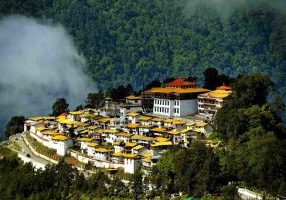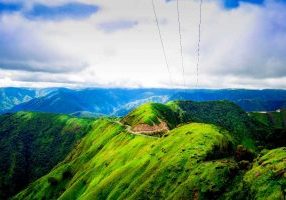The least explored, most mysterious and arguably the most beautiful region of India, the Northeast, known as the “Seven Sisters”, is connected to the rest of the country by a narrow stretch of land between Bhutan and Bangladesh, and was all but sealed off from the outside world until relatively recently. Arunachal Pradesh shares an extremely sensitive frontier with Chinese-occupied Tibet and, together with Nagaland, Manipur and Mizoram, a 1600km-long border with Myanmar.
PLACES TO VISIT IN THIS REGION
Many insurgencies, caused by a vast ethnic diversity, have fractured the region since Independence, with tribal groups pushing for autonomy as well as fighting each other. A huge influx of Bangladeshis in the last decade and the displacement of many indigenous people has created further tension. Though there has been improvement in security in some areas, others remain disturbed with occasional clashes and armed conflict on the fringes. Permits are required for travel in certain regions, notably Arunachal Pradesh, while some other areas, such as the Manipur Hills and Nagaland’s eastern fringes, have open access but remain highly volatile. Tourists, however, are not a target of violence and the extraordinary diversity of peoples and spectacular landscapes make a visit to the region well worth the effort. One of the world’s wettest monsoon belts, the area also boasts an astounding array of flora and fauna, estimated to represent fifty percent of India’s entire biodiversity.
Northeast India’s top cultural attractions
- Kaziranga National Park, AssamSpot the rare one-horned rhino on a dawn jeep safari deep into the jungle where, with luck, you can see wild elephant or even tigers.
- Living root bridges, MeghalayaIn India’s wettest state, entwined roots of the rubber tree form magnificent natural bridges, some centuries old, across waterways.
- Tawang Monastery, Arunachal PradeshIn a remote corner that was once Tibet, the largest Buddhist monastery in India maintains an ancient, unbroken tradition. The quiet chapel commemorating the sixth Dalai Lama lies close by.
- Namdapha National Park, Arunachal PradeshA beautiful, remote wildlife park, bordering Burma, with habitat from steamy foothills up to the snow line, and home to a huge variety of wildlife including the Hoolock gibbon and elusive big cats.
- Hornbill Festival, NagalandAn unmissable occasion and the highlight of the Northeast calendar, bringing together all the Naga tribes in their finery with music, dance and martial art displays.
- Dzükou Valley, NagalandTrek to a remote plateau of rolling green hills that is carpeted with flowers in the wet season.
Best time to visit Northeast India
Weather conditions are best from November to April, although the high-altitude areas of Arunachal, Meghalaya and Nagaland are extremely cold by December, and winter fog can disrupt road journeys. It rains heavily from May to the end of September, particularly in Meghalaya, but travel during this period has its own charm. In major cities such as Guwahati, Tezpur and Shillong, accommodation rates are not affected by the low season, but Kaziranga, Manas and the remote parts of Arunachal, Nagaland and Assam do offer off-season discounts.
Festivals in Northeast India
Religious festivals
- Yaoshang (March)Manipur’s version of Holi is celebrated with the thabal chongba folk dance.
- Aoling Monyu (April)Konyak festival in the Mon region of Nagaland marking the arrival of spring.
- Bihu (mid-April)The major festival of Assam, celebrated with singing, dancing and feasts in the villages, to mark the New Year and the onset of spring.
- Chapchar Kut (March)In spring before the new sowing season begins, this is the biggest harvest festival in Mizoram.
- Moatsu (May)Celebrated by the Ao tribe in Nagaland after the sowing season.
- Dree (July)The Apatanis of Ziro in Arunachal observe this agrarian festival in which animal sacrifices are common.
- Nongkrem (first week Nov)In Meghalaya, the Khasi tribe give thanks for the harvest over five days. Young men and women in traditional attire and heavy ornaments perform songs and dances at Smit, near Shillong.
- Torgya (Nov/Dec/Jan) and Losar (Tibetan New Year; Feb)Arunachal Pradesh festival of the Monpa people in Bomdila and Tawang, with colourful chaam (masked monastic dances) and religious ceremonies.
Music and cultural festivals
- Ziro Festival of Music (Sept)Four-day Central Arunachal outdoor music festival with apong (rice beer) and indie music, camping under the stars in the Ziro Valley.
- NH7 Weekender (Oct)This popular multiday urban music festival held its first Shillong edition in 2015 and is now slated to be an annual feature. Indian indie and global artists spanning genres of rock, funk, electro and more perform on various stages.
- Hornbill Festival (first week Dec)Held annually in Nagaland at the Naga Heritage Village in Kisama, this is among the Northeast’s largest occasion, showcasing the dance, music, food, games and intriguing culture of different local tribes.
Food and drink of Northeast India
Meat-based dishes, smoked, dried and pungent flavours, a liberal use of chilli and the distinct lack of typical Indian masala defines cuisine in the Northeast. The food is mostly mild, owing to the lack of spices that grow in the region, aside from some local herbs. Rice is a staple and the Tibetan momos and thukpa are ubiquitous. For drinks, salty yak-butter tea and local brews (known by various names including raksi, chang and apong) made of millet, maize or rice are recommended to keep off the chill.
In Assam, try the xaag (leaf vegetables), fish tenga (a souring agent), pitika (a pungent vegetable mash) and khorika (meat on a skewer). Meghalaya tends to go heavy on the pork, with dishes such as doh neiiong (pork with black sesame seeds) and the staple jadoh (rice cooked in meat stock with pork). Meghalayan cooking also features liberal use of seasonal mustard leaves and mushrooms. At local markets in Arunachal you’ll find strings of churpi (fermented rock-hard yak’s cheese), lai patta (mustard spinach) and dried river fish. Churpa, popular in Arunachal kitchens, is a pungent cheese stew with meat and vegetables. Naga cuisine consists of smoked, dried meats, bamboo shoot, anishi (dry yam leaves) and akhuni (fermented soy bean); wild herbs are used as flavouring agents. The star, of course, is the bhut jolokia or the king chilli, among the hottest in the world. Thalis are common in Manipur, with side dishes such as singju (raw papaya and chickpea salad) and iromba (fish and veg chutney) accompanying rice and fish or meat curries.
Mizo cuisine is fairly bland, consisting of forest vegetables and smoked meats; bai (vegetable stew with dry soy bean) is a staple.
Fish is abundant in Tripura, and berma, a pungent fermented fish paste, is used as flavouring.
Access, permits and tour operators
The Indian Government is currently investing to boost both local and international tourism to the region, and regulations have become quite relaxed. However, check the latest information with the Indian Embassy, Consulate, tourist office or visa agency before travelling. It is best to get permits while in India through a tour operator or by yourself in Guwahati.
Permits
Currently Arunachal Pradesh is the only one of the seven states that requires foreign visitors to obtain Restricted or Protected Area Permits (US$50 for a maximum of thirty days) prior to entry. Parties should theoretically consist of a minimum of two, accompanied by a travel agent, though in practice you can get away with saying the second person was “delayed”. Allow up to five working days to obtain the permit. Mizoram and Manipur currently only require registration on arrival at the entry point at the border. Indian nationals do require Inner Line Permits for Nagaland if travelling beyond Dimapur, Mizoram and Arunachal Pradesh prior to entry. Those Indians travelling to Mizoram by road will also need an ILP, but for those arriving by air, permits are issued on arrival. ILPs for Arunachal can be obtained online.
Make several photocopies of your passport and permits while travelling through the region. To obtain Inner Line Permits, Indian citizens should apply with two passport photographs to representatives of the state governments concerned. Applications should only take a day to process, and can be extended for up to six months in the relevant state capital. Passes are valid for the full period they are allocated for, no matter how many times you enter and exit a state.



